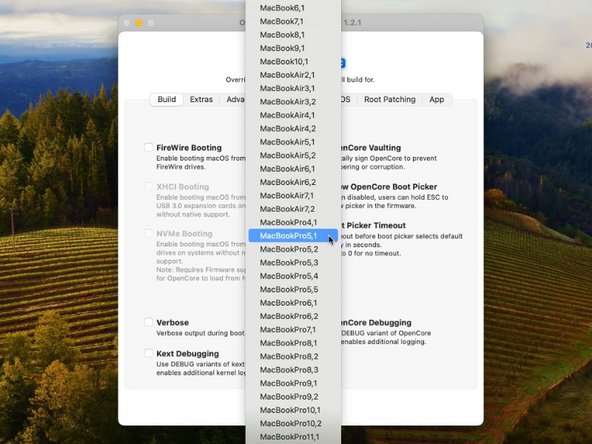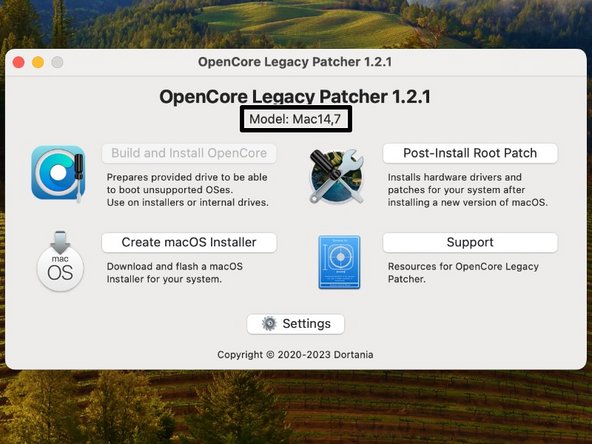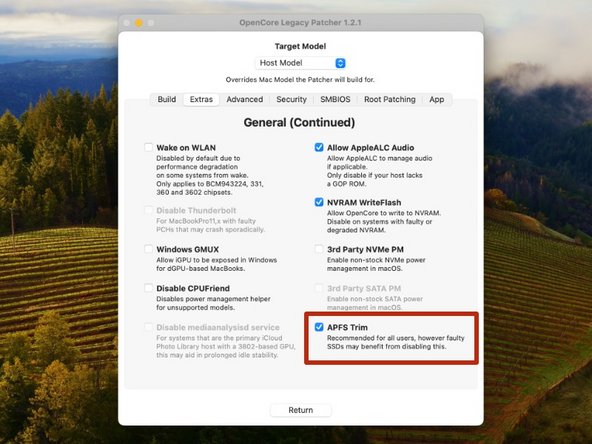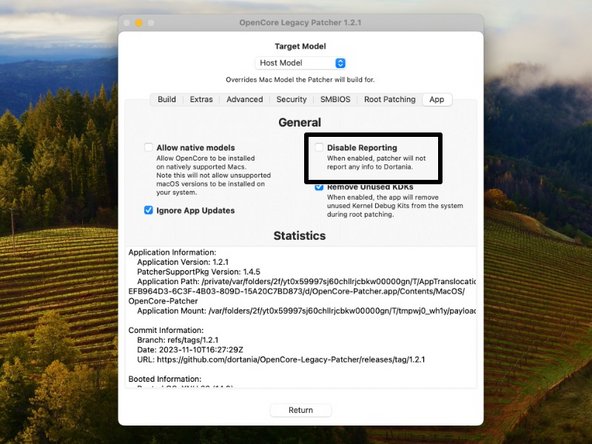はじめに
In this guide, we will install OpenCore onto your Mac's internal Hard Drive or Solid State drive.
必要な工具と部品
-
-
Now we get to install OpenCore on your Mac's Hard Drive or Solid State Drive!
-
-
-
First, we need to download the latest version of OpenCore.
-
Go to OpenCore's website: https://github.com/dortania/OpenCore-Leg...
-
Scroll past the information until you get to "Assets"
-
Click the link "OpenCore-Patcher.pkg"
-
-
-
Next, we have "Create macOS Installer"
-
This is basically the same command for making a macOS installer on a USB drive. 起動用USBを作成する方法
-
-
-
-
In extras, you'll see a bunch of NVRAM options. You'll probably leave most of this untouched.
-
Now, you will see "APFS Trim." If you are running a Mac that supports macOS High Sierra natively, your Mac will run APFS with or without this checked. If you are installing an older version of macOS (check out Guide #4 Continued), and you do not want to use APFS, uncheck this. If your Mac has a hard disk and NOT a Solid State drive, uncheck this.
-
-
-
Head over to "Advanced" on the panels.
-
The only thing you should change here is "FeatureUnlock." This fancy thing allows some of the newer things that old Macs can't do (Like AirPlay to Mac, Universal Control, Sidecar, etc.)
-
If it is set to "Partial" by default, that means you will get Night Shift, but nothing else. Your Mac must support Continuity in order for "Enabled" to actually give you these functions. If your Mac does support Continuity, but you have RAM issues later on, set this back to partial.
-
-
-
SMBIOS is the serial number and Board ID information about your Mac's Logic Board. If something terrible happens, OpenCore has a way to overwrite the Serial Number and Board ID. This does not change the Serial Number or Board ID on the logic board, but it makes macOS look at the custom EFI and force it to take that custom Serial Number.
-
-
-
Four quick troubleshooting tips:
-
If you get a window that looks like this, there is a good chance that Apple still supports your Mac. Double check to make sure of this.
-
Try giving OpenCore special permissions: go to System Preferences > Security > Full Disk Access > and allow OpenCore to have full disk access.
-
You may have to upgrade macOS before you can install OpenCore on the Hard Drive itself. In this case, install OpenCore (using the same settings) on an external USB drive.
-
-
-
Real quick, let's take a look at how to use OpenCore.
-
Reboot your Mac, and hold the Option (alt) key while starting up.
-
Your startup manager may look something like this:
-
Choose the "EFI Boot" option. Click the arrow pointing up to continue.
-
When OpenCore boots, you will be greeted to a new boot manager looking thing. Here, choose the drive you wish to start your Mac.
-
All done! You have successfully installed OpenCore! Now you can move to Guide #4 to update macOS.
35 の人々がこのガイドを完成させました。
6件のガイドコメント
@ralf41182 iFixit ist ein Wiki: Du kannst einfach Verbesserungen eintragen, am Besten gleich im englischen Original. Was würdest du ändern?
VauWeh -
Hello guys we installed a Monterrey version on a1278 - mid 2012. And the app Photos doesnt show on big screen or videos correctly
Hey there. These models should run Big Sur just fine without Root Patching. Monterey may have some issues. Try running root patching again. If issue persists, ask a new question in the iFixit forum, and post a screenshot of the issue.
Hallo.
Ich habe das System Sonoma via OpenCore Patcher installiert.
Leider ist danach die Anmeldung am AppStore nicht. möglich.
Gibt es dazu einen Lösung/Hinweise?
VG Chris





























































